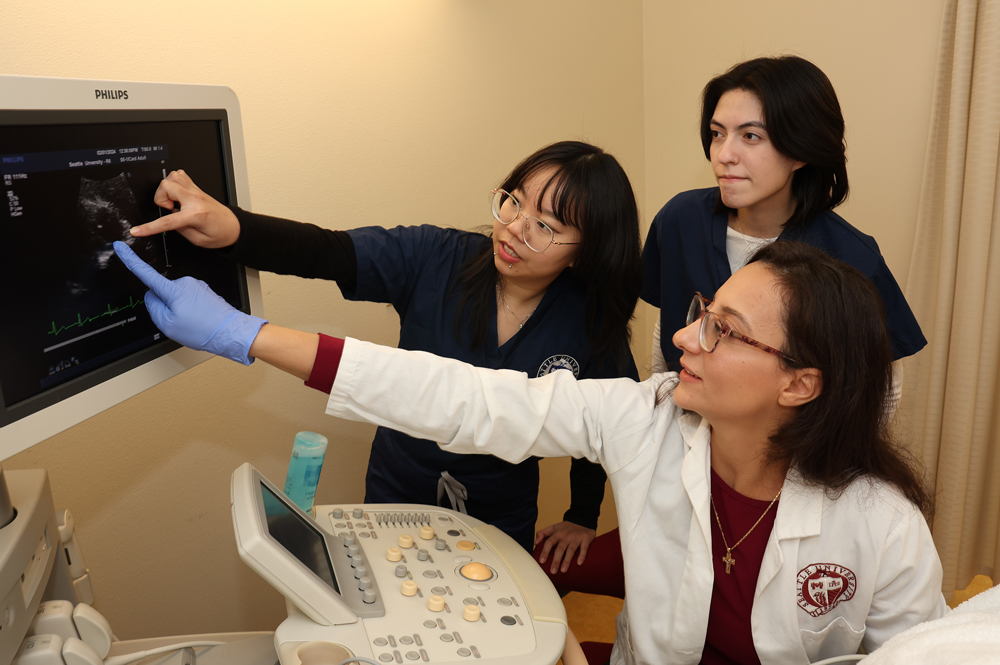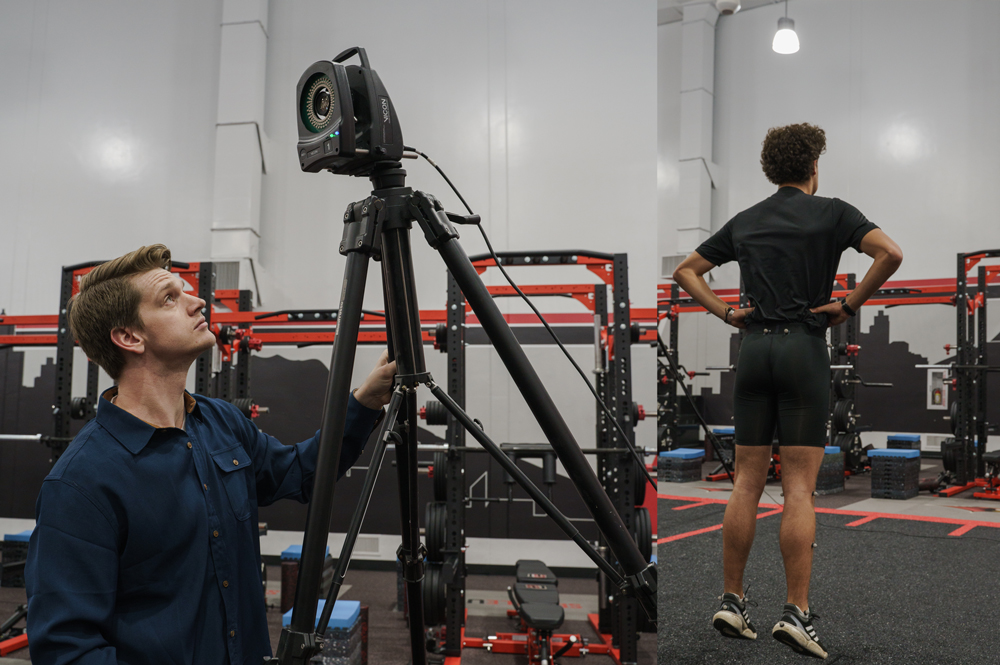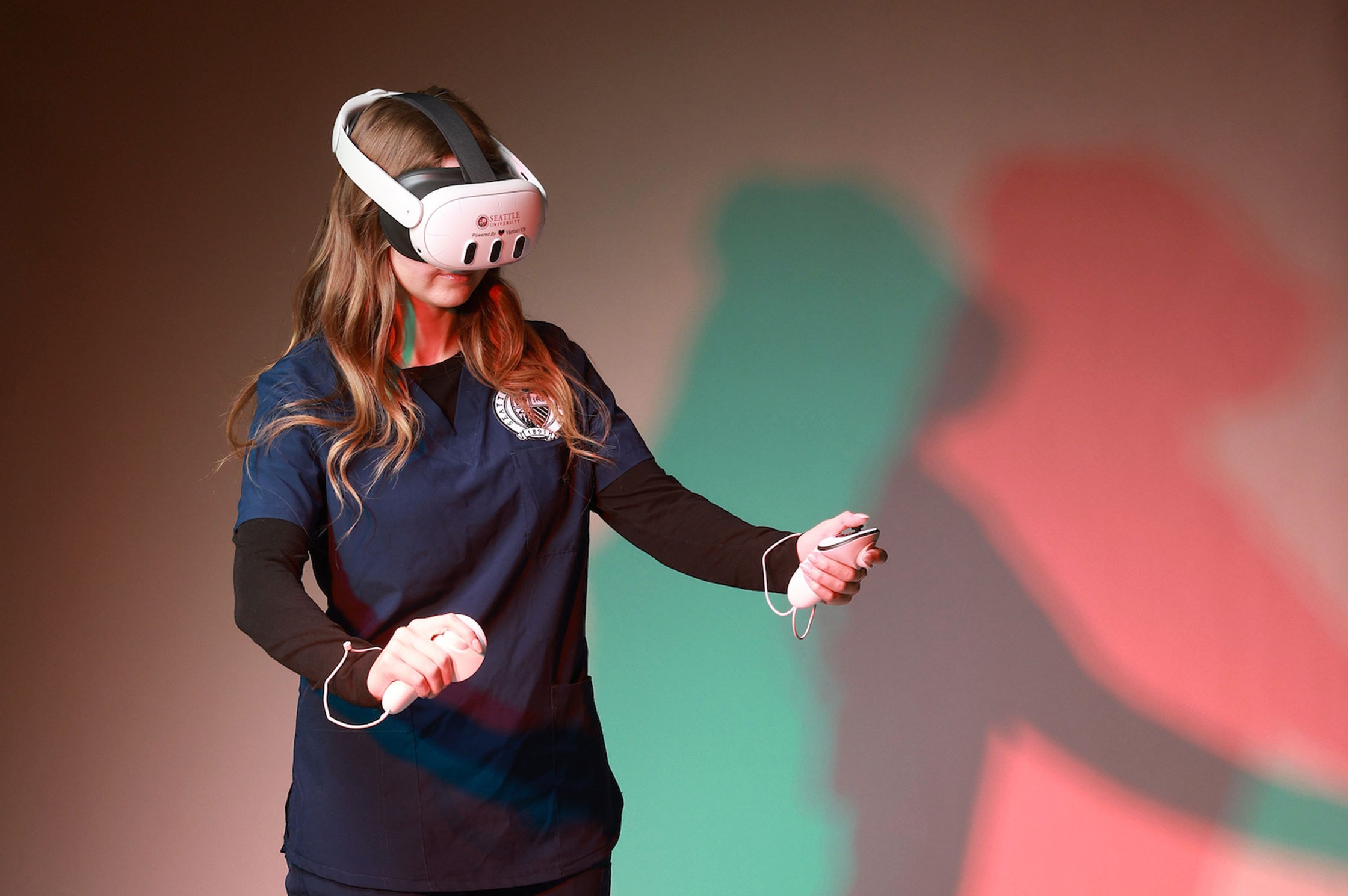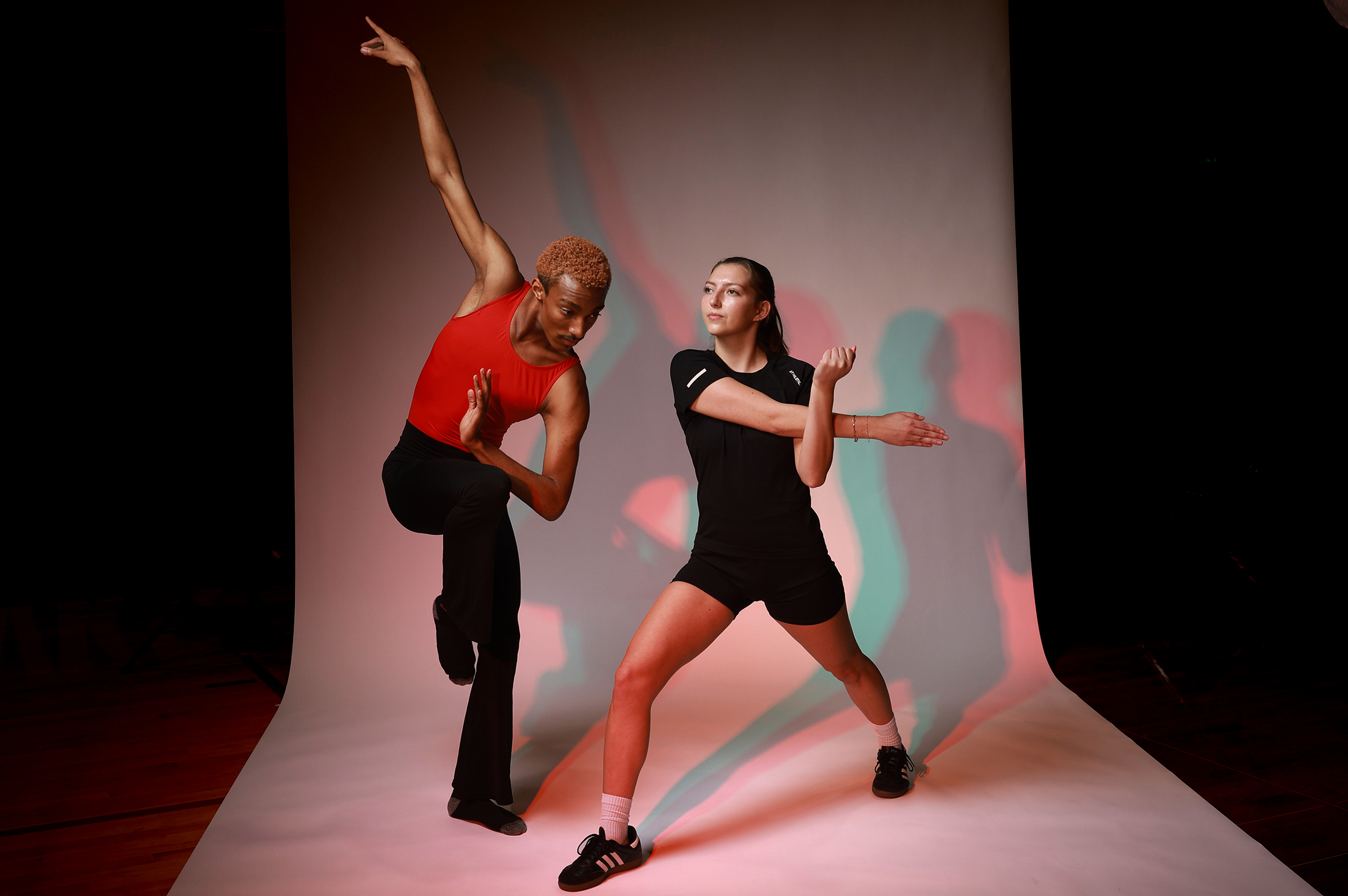A New Era of Care
Written by Tina Potterf, Kiyomi Kishaba
Friday, November 14, 2025
/0x14:1900x1226/prod01/channel_34/media/seattle-university/news-amp-stories/magazine/fall-2025/Landing-Page-Hero_2.jpg)
Seattle University’s College of Nursing and Health Sciences prepares future leaders across disciplines to deliver collaborative, equitable and compassionate health care.
In an effort to fill a critical need for health care practitioners and to build on the stellar reputation of producing high-quality, Jesuit-educated nurses and health care professionals who put the care for people first, Seattle University’s College of Nursing has expanded to become the College of Nursing and Health Sciences (CNHS).
“This will enable us to educate and graduate students who are ready to transition into practice and pursue careers where they can address complex health issues at individual, community and population levels,” says Dr. Butch de Castro, the Charles M. Pigott Endowed Dean.
Serving alongside Dean de Castro is Vice Dean for Nursing Melissa Owen, PhD, RN, CNE, FHFSA.
Stepping into this inaugural role, Dr. Owen says her goals are to enhance the existing Bachelor of Science in Nursing and Doctor of Nursing Practice programs “as we transition to competency-based education and create new programs to meet the ever-changing needs of the dynamic health care system.”
“As the College of Nursing and Health Sciences grows, it is important to remember our mission and core values,” says Dr. Owen, who was also appointed the Robert J. and Mary H. Bertch Endowed Professor in Nursing Leadership. “This includes employing innovative learning approaches with an emphasis on developing future nurse leaders who focus on caring for the whole person with competence and compassion.”
The expansion aligns with national health care priorities. The U.S. Agency for Health Care Research and Quality has identified whole-person care as a priority and how it improves patient care coordination and outcomes.
Since being established in 1935, Seattle University nursing programs have prepared highly regarded health care professionals who advance health equity and improve outcomes for individuals and communities across the Pacific Northwest and beyond.
While health sciences is an important part of this expansion, nursing programs remain the cornerstone of the college, including the Bachelor of Science in Nursing and Doctor of Nursing Practice programs, with specializations in Acute Care, Nurse-Midwifery, Family and Primary Care, Health Systems Leader, Psychiatric Mental Health and Women’s Health.

As part of this extended reach, the Department of Kinesiology is now housed within the College of Nursing and Health Sciences, joining the growing Diagnostic Ultrasound program, which will anchor the college’s health science offerings that includes public health.
“Recently, there’s been more recognition of upstream causes and social determinants of health that don’t require clinical services but require policy and population level interventions,” says de Castro. “Public health students will be the ones charged with making a difference on those levels, which will then have a positive benefit for families and communities.”
“Without a robust health workforce, the well-being of a population will suffer and a society’s ability to promote the physical and psychological health of its people has implications across all aspects of community and industry.”
Dean de Castro outlines key priorities for the college over the next five years. They are:
- Carrying on Seattle University’s tradition of infusing health professions academic programs with Jesuit values that distinguish graduates.
- Aligning the development of academic programs with workforce trends and societal needs.
- Developing an interprofessional education initiative that facilitates co-learning opportunities for students across health professions training programs.
- Building out a center of excellence for health care simulation that supports student learning with the latest, innovative equipment and technologies, coupled with best practice teaching strategies.
“Given persistent health inequalities resulting from inequitable conditions across several communities, this expansion is Seattle University’s response to a civic imperative,” says de Castro.
SU’s Diagnostic Ultrasound Program at Forefront of Research and Innovation
For nearly five decades, Seattle University’s Diagnostic Ultrasound program has been preparing the next generation of sonographers to care for patients in an ever-changing health care landscape.
Originally part of the College of Science and Engineering, the program transitioned to the College of Nursing in 2018, aligning it thematically closer with nursing programs and giving it greater visibility.
The success of the program, now under Health Sciences as part of the expanded College of Nursing and Health Sciences, is a full circle moment for its director, Mirette Aziz, who herself graduated from the program in 2010.
“Being part of the CNHS has been incredibly positive,” says Aziz, who returned to SU as a faculty member in 2019. “It recognizes ultrasound as a vital part of health sciences and has opened doors to deeper collaboration with other health programs, broadening learning opportunities.”
Unlike many institutions that offer only certificate or associate-level training, SU provides a four-year Bachelor of Science in Diagnostic Ultrasound. The program also offers a two-year, post-baccalaureate pathway for students who already hold an undergraduate degree. Students choose one of three specialty tracks—general, cardiac or vascular—and benefit from hands-on experience through extensive year-long clinical rotations.

During their final year, students complete a clinical placement at one of nearly 200 partner sites, including hospitals and clinics across Washington, Oregon, California and beyond. The flexibility of out-of-state site options appeals to students who might reside outside of Washington and want to work closer to home or in their home state.
“The clinical year is where everything comes together,” says Aziz. “Students get to apply their training in real-world settings and many secure job offers directly from their rotations.”
The program has been at the forefront of research and innovation. In 2024, Seattle University was selected as one of only three universities nationwide to pilot a study on virtual reality (VR) ultrasound training, in partnership with Inteleos and Vantari VR, for what could become a new standard in ensuring confidence and advancement in patient care.
Faculty and students tested headsets, software and protocols designed to simulate real ultrasound procedures. During early-stage testing, students and faculty provided direct feedback of what worked and what could be improved for better utilization of VR in educational practice.
And beginning this fall, SU was named an official Inteleos/Vantari Beta Site—one of only a handful worldwide—giving students and faculty early access to new VR modules and the opportunity to directly shape future training content aligned with the American Registry for Diagnostic Medical Sonography. The program will put the VR technology—via two headsets—into practice. “We’re excited to integrate VR into labs so students can practice full exams, including identifying pathologies, before they ever scan a patient,” says Aziz.
Seattle University’s inclusion in the VR study stems not only from the program’s outstanding reputation in clinical and hands-on lab training but also because of a connection with double alum Dale Cyr, a 1981 graduate of the Diagnostic Ultrasound program (and 1998 MBA graduate) who is CEO and executive director of Inteleos. Inteleos is one of the world’s largest credentialing organizations for health care professionals, including medical sonographers.
“We conducted an ambitious research initiative to explore whether advanced virtual and augmented reality experiences can reliably certify and validate the practical, patient-care skills essential to health care delivery,” says Cyr. “Seattle University’s involvement in this study not only reflected its leadership in clinical education but also exemplified its commitment to advancing health care excellence through innovation.”
Cyr, who hails from upstate New York—about as far away from Seattle as you can be—was drawn to SU as it was one of only a few universities offering a degree in what was then, in the late 1970s, a relatively new health professions field. He was sold when he learned that the program was led by Joan Baker, one of the pioneers in medical ultrasound.
“I believe being situated in Seattle offers students unique clinical internship opportunities, thanks to the region’s world-class health care systems and robust ultrasound community,” he says. “Seattle University itself gives the ultrasound program unique status among its peers given its reputation of providing a high-quality education and a vibrant campus experience.”
Graduates of the program go on to careers as sonographers, researchers, consultants and educators, with some pursuing advanced degrees in medicine or health care management. While most enter clinical practice, alumni have also made their mark in medical device companies and professional associations. And, adds Aziz, alumni of the program have consistently earned national recognition by winning prestigious awards for student research, underscoring the program’s leadership in both clinical education and advancement of the health care industry.
Kinesiology’s Move Opens Doors to Clinical Work and Research
As the study of human movement, kinesiology is essential to health and well-being. Formerly under the College of Arts and Sciences, the program now is part of the College of Nursing and Health Sciences, opening strategic opportunities for interdisciplinary study and research.
“This creates a structure where kinesiology, nursing and diagnostic ultrasound students can learn about other disciplines so that they can practice more effectively when they graduate,” says Dean Butch de Castro.
The department’s Acting Associate Chair and Assistant Professor Dr. Brittany Heintz Walters teaches neuromechanics and motor control—how the nervous system controls movement in the body. However, she notes that kinesiology is a very wide-ranging field.
“Kinesiology encompasses a wide spectrum, from working with patient populations in rehabilitation, such as stroke survivors relearning how to walk, to optimizing athletic performance,” says Dr. Heintz Walters.
Graduates of kinesiology often pursue careers in physical and occupational therapy, athletic training and coaching. More recently, Dr. Heintz Walters noticed incoming students are also interested in entrepreneurship, with plans to use their foundational knowledge of kinesiology to open their own businesses, like a gym. On the graduate level, the kinesiology program recently revamped its clinical track with data analytics, which is often applied to improving performance on sports teams.
“The expanded college transition is incredibly exciting,” says Dr. Heintz Walters. “We are deeply grateful for the strong partnership and support we have experienced in the College of Arts and Sciences. Joining CNHS builds on that foundation and creates transformative opportunities for interprofessional collaboration in teaching and research.”
Additionally, there will be opportunities for hands-on clinical and research experiences with other health science departments and experts that better prepare students to apply for graduate and doctoral programs. The impressive breadth of faculty expertise also creates more avenues for research across disciplines where students from kinesiology, nursing and ultrasound can work together.

“When a patient or client comes to a clinician or a practitioner, the most effective solutions are often multifaceted,” says Dr. Heintz Walters. “Being part of CNHS allows kinesiology students to learn alongside future nurses, ultrasound technologists and other health professionals so they graduate ready to contribute as part of a collaborative team.”
To provide students with experience and to be accessible to the community, the kinesiology department runs a mobile lab that brings equipment from the laboratory to participants for outreach, service or data collection. Led by Dr. Kyle DeRosia, an assistant teaching professor in the kinesiology department, students in the mobile lab provide performance and health assessments locally in Seattle at health fairs, charity races and student-focused events. The mobile team even traveled to Oregon and California for research studying Olympic kayakers.
“This allows us to study our participants in their environment, providing us with more applicable findings than what may be collected in a typical laboratory setting,” says Dr. DeRosia.
The goal is to continue community engagement utilizing the mobile lab together with other programs within health sciences, says Julius Moss, ’22 EdD, interim chair of the kinesiology department.
“We’re taking the opportunity to revisit our curriculum for the purpose of expanding our scope and range regarding co-curricular activities within our new college,” says Moss. “We’re adapting our approach to develop graduates who will be prepared for changes in the industry and we believe that CNHS is the perfect fit for us to achieve our goals.”
Check out the print edition of the fall magazine for a Q&A with Dean de Castro and a spotlight on the Women's Health Nurse Practitioner program.


/0x42:2400x1558/prod01/channel_34/media/seattle-university/news-amp-stories/images/ChrisWhidbeyChemistry_yk_014.JPG)
/65x0:1124x669/prod01/channel_34/media/seattle-university/news-amp-stories/images/ISU-Presidential_Speaker_Series_-Stephen_Macedo_KP-77-(1).jpg)
/120x0:2080x1238/prod01/channel_34/media/seattle-university/news-amp-stories/images/international-conference-group-shot.JPG)